Rewriting the 5G Data Plane: XDP/eBPF in the Fast Lane of UPF¶
Author: Satyam Dubey
Published: June 17, 2025

In the ever-evolving world of 5G, the User Plane Function (UPF) is the backbone of ultra-fast data delivery. With increasing throughput, low-latency expectations, and the explosion of IoT devices, traditional kernel networking struggles to keep up. The eBPF/XDP stack introduces programmable, high-performance packet processing at the NIC level, addressing many of these challenges.
Note: Prior knowledge of eBPF is assumed. For an introduction, refer to this beginner-friendly guide. Familiarity with 5G core architecture and networking is also recommended.

What is XDP?¶
The packet flow diagram above illustrates key processing stages inside the Linux kernel networking stack, highlighting interception points for tasks like filtering, forwarding, or dropping packets.
Interpreting the Packet Flow Diagram¶
This flow is organized into four main layers:
Link Layer: Early packet handling where drivers hand packets to the kernel.
Network Layer: Routing, connection tracking, NAT, etc.
Protocol Layer: L4-specific logic (TCP/UDP).
Application Layer: Sockets and user applications.
XDP can hook at the earliest stage, immediately after the (start), in the NIC driver, before packet memory allocation. It allows the highest-speed possible processing with minimal system overhead.
Why This Matters¶
Bypasses layers such as Netfilter, qdisc, and routing logic.
Enables line-rate filtering, DDOS protection, or forwarding from the driver point.
Avoids kernel sk_buff allocation and associated system costs.
XDP Modes¶
Native Mode: Runs within the NIC driver for maximum performance, with true zero-copy. Requires compatible drivers (e.g., ixgbe, mlx5, virtio-net).
Generic Mode: Executes after standard packet allocation, universally supported but slower than native.
Offloaded Mode: Executes inside NIC firmware for SmartNICs, leveraging hardware acceleration.
XDP Verdicts¶
XDP_DROP: Drop the packet immediately.
XDP_PASS: Pass into the kernel stack.
XDP_REDIRECT: Redirect to another interface or AF_XDP socket.
XDP_TX: Transmit back out on the same interface.
XDP_ABORTED: Signals processing faults for debugging.
What is the UPF?¶
The User Plane Function (UPF) in 5G networks is core to data transport between RAN (gNB) and external Data Network (DN). The UPF’s responsibilities include:
GTP-U tunneling/decapsulation.
IP forwarding and NAT.
QoS enforcement.
Lawful Interception.
Traffic classification.
Usage metering.
Interaction with Session Management Function (SMF).
UPF is effectively the “traffic controller” in 5G, routing user data efficiently to its destination.
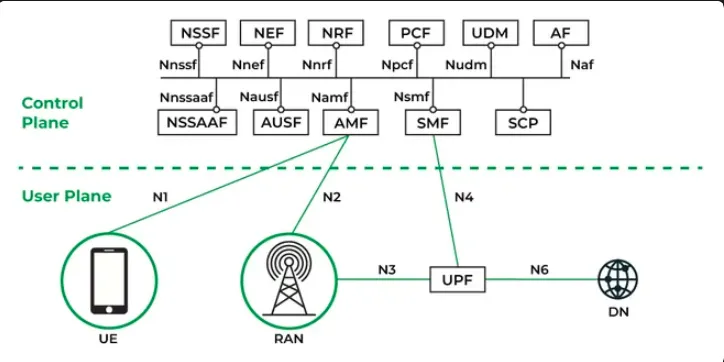
What Makes a Desired UPF in 5G/6G?¶
Modern UPF requirements include:
Ultra-Low Latency (URLLC Ready)
High Throughput
Horizontal Scalability
Cloud-Native Architecture
Programmability
Robust Flow and Session Management
Security and Isolation
Observability and Telemetry
Hardware Agnostic
Resilient and Fault-Tolerant
Where Traditional UPFs Fall Short¶
Traditional UPFs process packets through the full kernel stack, leading to:
Context switching and memory copy overhead.
Latency that is prohibitive for URLLC or high-throughput scenarios.
DPDK UPFs — Speed with Strings Attached¶
DPDK-based UPFs improve throughput using kernel bypass and user-space polling, but:
Require hardware with DPDK driver support.
Present scaling challenges in Kubernetes.
Offer limited integration with Linux observability tools.
Scale poorly with rigid hardware dependencies.
eBPF/XDP UPFs¶
eBPF/XDP-based UPFs offer a high-performance, programmable, in-kernel data path with:
Near-DPDK performance without hardware dependency.
No user-space context switches.
Native integration into containerized/cloud (e.g., K8s) environments.
Full observability (e.g., via BPF maps, tracepoints).
Programmable behavior for instant adaptation.
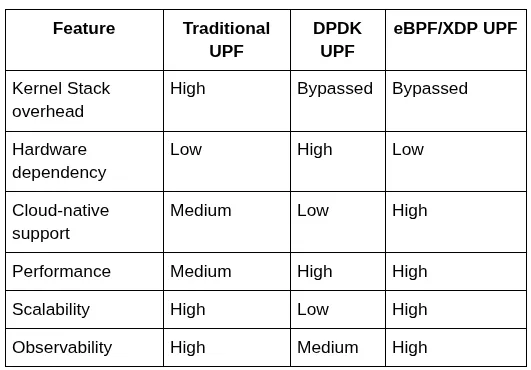
Noteworthy Open Source eBPF-Based UPF Projects¶
1. eUPF — Edgecom LLC¶
Architecture:
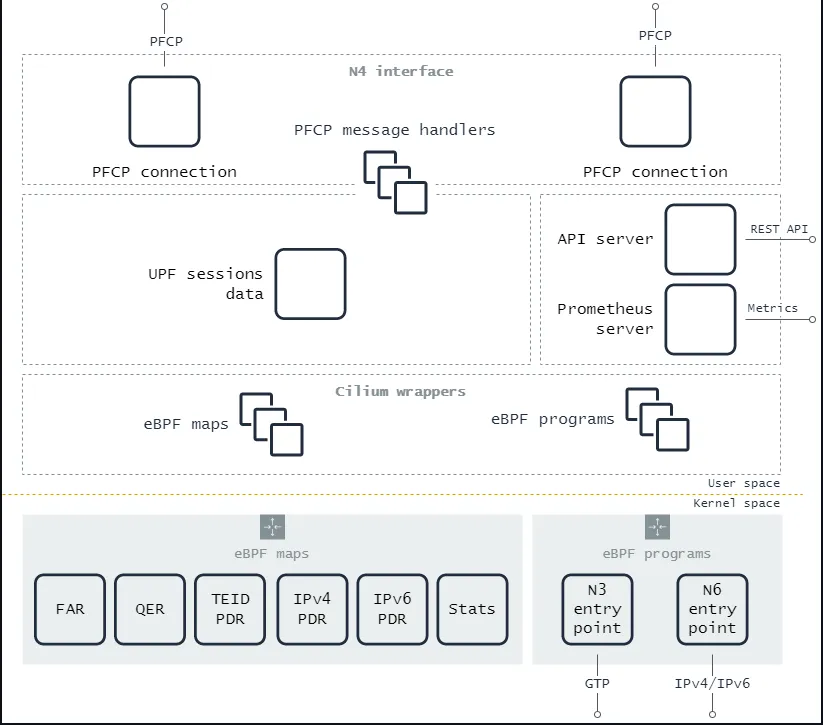
Kernel-resident data path via XDP/eBPF.
GTP-U, PFCP message processing, modular Go and C code.
KPIs: 25Gbps/core, <150μs RTT (Intel X550 NIC).
Kubernetes-native.
2. OAI-UPF (OpenAirInterface)¶
Architecture:
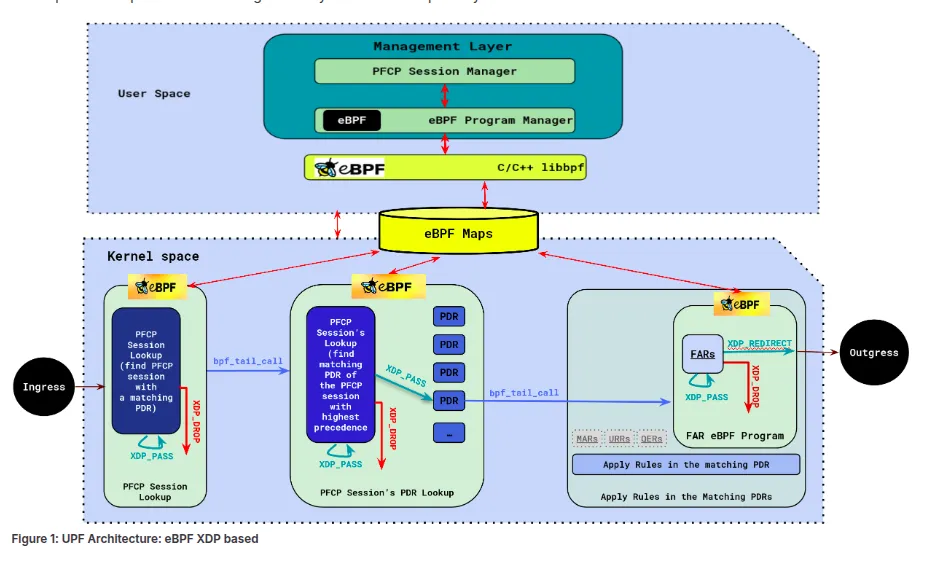
Modular, integrates with OAI-AMF/SMF, flexible architecture.
Supports both kernel/user-space paths.
Written in C++/C, support for eBPF acceleration.
3GPP Rel-15 compliant with evolving QER support.
3. Ella Core¶
Architecture Overview:
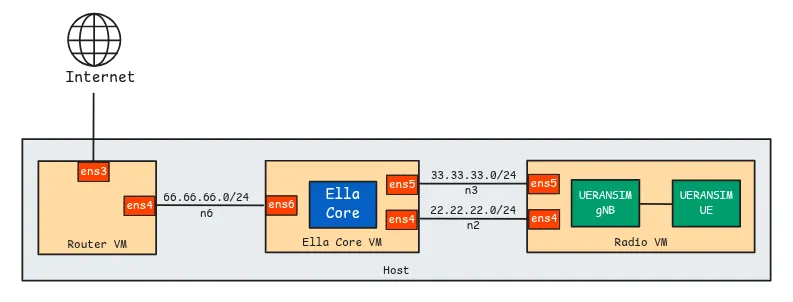
Monolithic, cloud-native, lightweight, PVC-backed database.
TLS offloading, data plane in virtualized environment.
500+ concurrent PDU sessions supported in tests.
Integrated with Kubernetes; C for eBPF, Go for core.
Performance:
Performance test link
UPF Performance Comparison Summary¶
Performance metrics: comparison of eUPF (XDP), Open5GS-UPF, Free5gc-UPF, UPG-VPP
Testbed details:
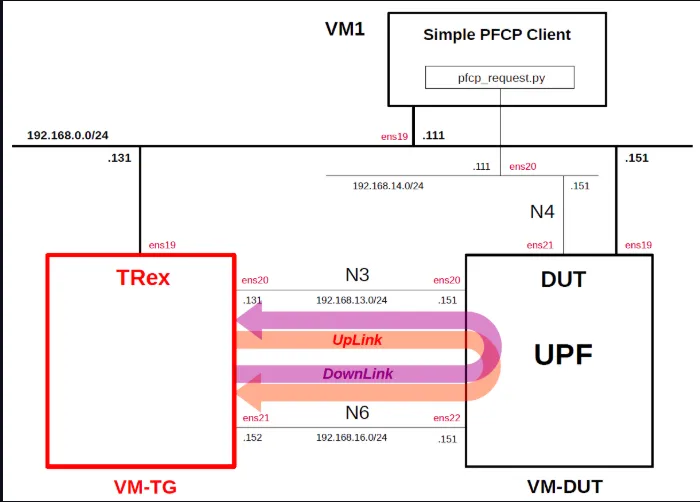
Load (1400B UDP payload):
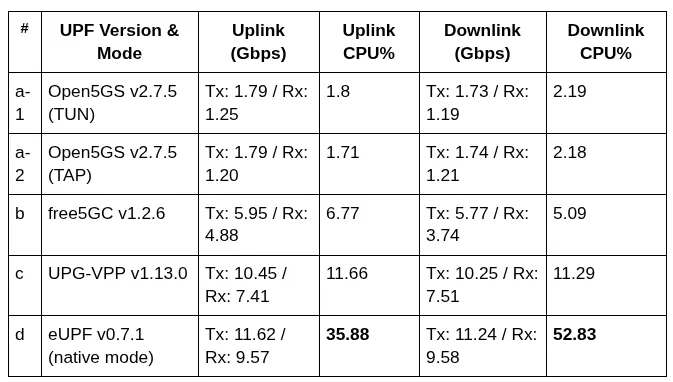
Latency (ms):
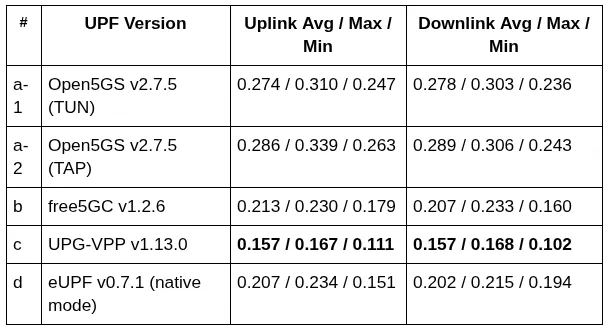
N6 Raw Throughput:
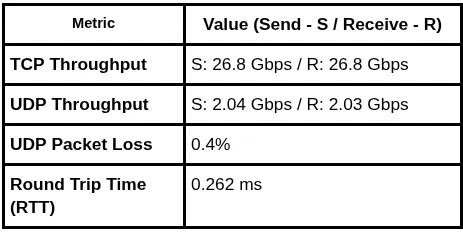
Key insights:
eUPF (XDP-native) delivers highest throughput, with higher CPU usage.
UPG-VPP achieves best latency (<0.16ms).
Open5GS and free5GC offer medium scalability and mid-tier performance.
Results depend on virtualization, NIC drivers, and hardware.
The Future of eBPF in 6G, AI-Native Networks¶
6G evolution will require:
Ultra-low latency and deterministic performance.
AI-native orchestration and programmable data planes.
Continuous learning using real-time telemetry (eBPF maps, tracepoints).
SmartNICs, DPUs, and offload into hardware-managed eBPF.
eBPF is expected to underpin in-kernel decision-making, real-time traffic adaptation, and integration with AI/ML pipelines at scale in next-generation mobile networks.